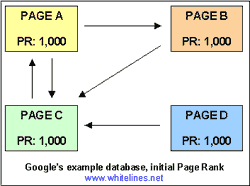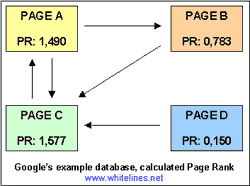Google PageRank calculationGoogle's most mysterious ranking influencer, the Google PageRank (PR), has been the topic of many discussions and observations. The way the Google PageRank calculation works is still not 100% clear today, but I thought it might be useful to write the concept of the original mechanism down in plain English and show it using a simple example. The Google PageRank (PR) is calculated for every webpage that exists in Google's database. It's real value varies from 0,15 to infinite, but for representation purposes it is converted to a value between 0 and 10 (from low to high). The calculation of the PR for a page is based on the quantity and quality of webpages that contain links to that page. According to Sergey Brin and Lawrence (Larry) Page, Co-founders of Google, the PR of a webpage is calculated using this formula: PR(A) = (1 - d) + d * SUM ((PR(I->A)/C(I)) Where:
In other words: The PR of a page is determined by the PR of every page I that has a link to page A. For every page I that points to page A, the PR of page I is devided by the number of links from page I. These values are cumulated and multiplied by 0,85. Finally 0,15 is added to this result, and this number represents the PR of page A. To illustrate how this calculation works we defined the following simplified example. In this example we use an imaginary Google database containing only four (4) pages that all have an initial PR value of 1 (the above formula needs an assumed start PR value for every page). These four pages have the linkstructure as shown in the first picture. In practice Google calculates the PageRank for billions of pages. Our model is simplified to show the evaluation of a PageRank.
To determine the PR for pages A to D the formula has to be executed several times. For every calculation we use the PR results of the former calculation. In this example the final PageRanks are found after 20 iterations. The next picture shows the calculated PR for every page.
Have a look at this spreadsheet to find the calculation model. Dmoz.org and Yahoo Finally I would like to mention two special sites that influence the Google PageRank of your webpage. Inclusions in the Open Directory Project and Yahoo! directories (www.dmoz.org and www.yahoo.com) seem to offer your site an extra boost in the PageRank calculation. A clear explanation for their influence is unknown to me, but it is obvious that a top-10 listing shows many sites that are included in the Google Directory. And this Google directory is a copy of the Dmoz.org database. Therefore I recommend you to get listed in both directories. That's about it. Many things are know and many things are unknown about the internals of Google. I guess we have to accept that. However, I trust you can use this information to get a step ahead in your plans to receive a higher Google ranking. In case you have any comments or additions, please feel free to send them in. Whitelines Communications
PS: Use the Google toolbar to determine the PR of webpages. |



